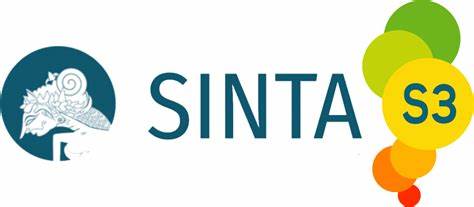SOCIAL AVOIDANCE IN MODERN SOCIETY IN SAD GIRLS BY LANG LEAV
Abstract
This study discusses the phenomenon of social avoidance in modern society as depicted in the novel ‘Sad Girls’ by Lang Leav. By using a qualitative descriptive analysis approach, this study explores the characteristics and factors that influence social avoidance behavior, as well as its impact on the main character's social avoidance. The data was collected from quotations, sentences, or character dialog in the novel SAD GIRLS which shows social avoidance in modern society. Then, the data was analyzed using social avoidant theory. The results of this study revealed that the characteristics of social avoidance include avoiding social encounters, minimizing conversations, and feeling uncomfortable in their social environment. In addition, two factors that influence a person to be socially avoidant are internal and external. Furthermore, there are several impacts of socially avoidant behavior, which include loneliness and isolation, difficulties in professional growth, and strained relationships.
References
Aprilia, A., & Aminatun, D. (2022). Investigating Memory Loss: How Depression Affects Students’memory Endurance. Journal of English Language Teaching and Learning, 3(1), 1-11.
Bland, A. R., Roiser, J. P., Mehta, M. A., Sahakian, B. J., Robbins, T. W., & Elliott, R. (2022). The impact of COVID-19 social isolation on aspects of emotional and social cognition. Cognition and Emotion, 36(1), 49-58.
Chmil, H., Kuznietsova, I., Mishchenko, M., Oliynyk, O., & Demeshchenko, V. (2021). Intangible cultural heritage as a resource for consolidating modern Ukrainian society. Linguistics and Culture Review, 5(S4), 747–760. https://doi.org/10.21744/lingcure.v5ns4.1713
Drigas, A., Mitsea, E., & Skianis, C. (2021). Neuro-Linguistic Programming, Positive Psychology & VR in Special Education. Scientific Electronic Archives, 15(1). https://doi.org/10.36560/15120221497
Eres, R., Lim, M. H., Lanham, S., Jillard, C., & Bates, G. (2021). Loneliness and emotion regulation: implications of having social anxiety disorder. Australian Journal of Psychology, 73(1), 46–56. https://doi.org/10.1080/00049530.2021.1904498
Fernández-Theoduloz, G., Paz, V., Nicolaisen-Sobesky, E., Pérez, A., Buunk, A. P., Cabana, Á., & Gradin, V. B. (2019). Social Avoidance in Depression: A Study Using a Social Decision-Making Task. Journal of Abnormal Psychology, 128(3), 234–244. https://doi.org/10.1037/abn0000415
Gellner, A. K., Voelter, J., Schmidt, U., Beins, E. C., Stein, V., Philipsen, A., & Hurlemann, R. (2021). Molecular and neurocircuitry mechanisms of social avoidance. Cellular and Molecular Life Sciences, 78, 1163-1189.
Griffiths, M. D., Kuss, D. J., & Demetrovics, Z. (2014). Social networking addiction: An overview of preliminary findings. Behavioral addictions, 119-141.
Ihsani, A., Amiruddin, F., Febriyanti, N., & Abdan Syakuuroo, S. K. (2021). Gus Dur’s Multicultural Da’wah and Its Relevance to Modern Society. El Harakah, 23(1), 103.
Ji, S., Zhang, T., Ansari, L., Fu, J., Tiwari, P., & Cambria, E. (2021). MentalBERT: Publicly Available Pretrained Language Models for Mental Healthcare. http://arxiv.org/abs/2110.15621
Lawlor, A., & Kirakowski, J. (2014). Online support groups for mental health: A space for challenging self-stigma or a means of social avoidance? Computers in Human Behavior, 32, 152–161. https://doi.org/10.1016/j.chb.2013.11.015
McCloskey, K. D., Cox, D. W., Ogrodniczuk, J. S., Laverdière, O., Joyce, A. S., & Kealy, D. (2021). Interpersonal problems and social dysfunction: Examining patients with avoidant and borderline personality disorder symptoms. Journal of Clinical Psychology, 77(1), 329–339. https://doi.org/10.1002/jclp.23033
Meshcheryakova, N. N., & Vasilenko, L. A. (2023). The New Social Developments of Durkheim and Merton Theories on Anomie in Modern Society. Social Evolution and History, 22(1), 102–122. https://doi.org/10.30884/seh/2023.01.05
Mikhailova, O. B., Khairova, Z. R., & Bashkin, E. B. (2021). Mental Health as a Priority of Modern Society: Results of the International Scientific and Practical Conference on Commitment to Mental Health. RUDN Journal of Psychology and Pedagogics, 18(4), 915–922. https://doi.org/10.22363/2313-1683-2021-18-4-915-922
Ottenbreit, N. D., Dobson, K. S., & Quigley, L. (2014). An examination of avoidance in major depression in comparison to social anxiety disorder. Behaviour Research and Therapy, 56(1), 82–90. https://doi.org/10.1016/j.brat.2014.03.005
Özmete, E., & Pak, M. (2020). The Relationship between Anxiety Levels and Perceived Social Support during the Pandemic of COVID-19 in Turkey. Social Work in Public Health, 35(7), 603–616. https://doi.org/10.1080/19371918.2020.1808144
Pelekh, Y. (2020). Urgent Issues and Modern Challenges of Higher Education. Problems of Education in the 21st Century, 78(5), 671–673. https://doi.org/10.33225/pec/20.78.671
Pittig, A., Pawlikowski, M., Craske, M. G., & Alpers, G. W. (2014). Avoidant decision making in social anxiety: the interaction of angry faces and emotional responses. Frontiers in psychology, 5, 1050.
Potočan, V., Mulej, M., & Nedelko, Z. (2021). Society 5.0: balancing of Industry 4.0, economic advancement and social problems. Kybernetes, 50(3), 794–811. https://doi.org/10.1108/K-12-2019-0858
Pylypenko, S. G. (2021). Philosophical reflections in the challenges of the post-modern society. Revista Amazonia Investiga, 10(48), 81–88. https://doi.org/10.34069/ai/2021.48.12.9
Reinhard, M. A., Nenov-Matt, T., & Padberg, F. (2022). Loneliness in personality disorders. Current Psychiatry Reports, 24(11), 603-612.
Roberts, J. E., Crawford, H., Will, E. A., Hogan, A. L., McQuillin, S., Tonnsen, B. L., ... & Brewe, A. M. (2019). Infant social avoidance predicts autism but not anxiety in fragile X syndrome. Frontiers in Psychiatry, 10, 199.
Sahari, A., & Putra, C. R. W. (2024). Analisis Pertahanan Diri Tokoh Utama dalam Novel Lembata Karya F. Rahardi. Semantik, 13(1), 71-86.
Strickland, K., Levengood, A., Foroughirad, V., Mann, J., Krzyszczyk, E., & Frère, C. H. (2017). A framework for the identification of long-term social avoidance in longitudinal datasets. Royal Society Open Science, 4(8). https://doi.org/10.1098/rsos.170641
Suleimenov, I. E., Gabrielyan, O. A., Malenko, S. A., Vitulyova, Y. S., & Nekita, A. G. (2021). Algorithmic Basis Of Battle Neural Networks And Crisis Phenomena In Modern Society. 247–255. https://doi.org/10.15405/epsbs.2021.12.03.33
Thai, T. T., Le, P. T. V., Huynh, Q. H. N., Pham, P. T. T., & Bui, H. T. H. (2021). Perceived stress and coping strategies during the covid-19 pandemic among public health and preventive medicine students in vietnam. Psychology Research and Behavior Management, 14, 795–804. https://doi.org/10.2147/PRBM.S317059
Thu, T. N. M. (2021). The Economic Factors Affecting Family In Modern Vietnamese Society. The journal of contemporary issues in business and government, 27(2), 790-794.
Trew, J. L., & Alden, L. E. (2015a). Kindness reduces avoidance goals in socially anxious individuals. Motivation and Emotion, 39(6), 892–907. https://doi.org/10.1007/s11031-015-9499-5
Trew, J. L., & Alden, L. E. (2015b). Kindness reduces avoidance goals in socially anxious individuals. Motivation and Emotion, 39(6), 892–907. https://doi.org/10.1007/s11031-015-9499-5
Wang, Y., Bai, Y., Xiao, X., Wang, L., Wei, G., Guo, M., ... & Zheng, C. (2022). Low-intensity focused ultrasound stimulation reverses social avoidance behavior in mice experiencing social defeat stress. Cerebral Cortex, 32(24), 5580-5596.
Downloads
Published
Issue
Section
License

This work is licensed under a Creative Commons Attribution-ShareAlike 4.0 International License.
The author is responsible for acquiring the permission(s) to reproduce any copyrighted figures, tables, data, or text that are being used in the submitted paper. Authors should note that text quotations of more than 250 words from a published or copyrighted work will require grant of permission from the original publisher to reprint. The written permission letter(s) must be submitted together with the manuscript.




